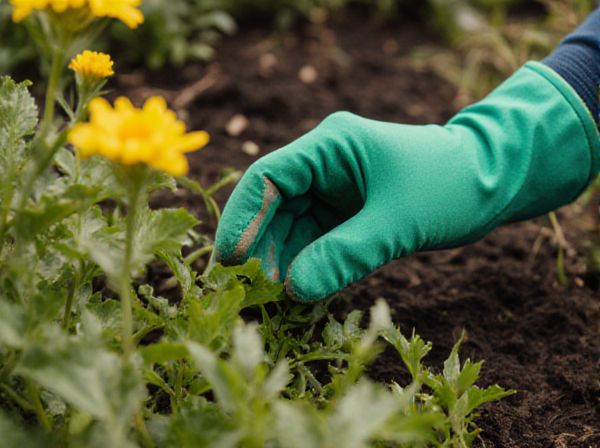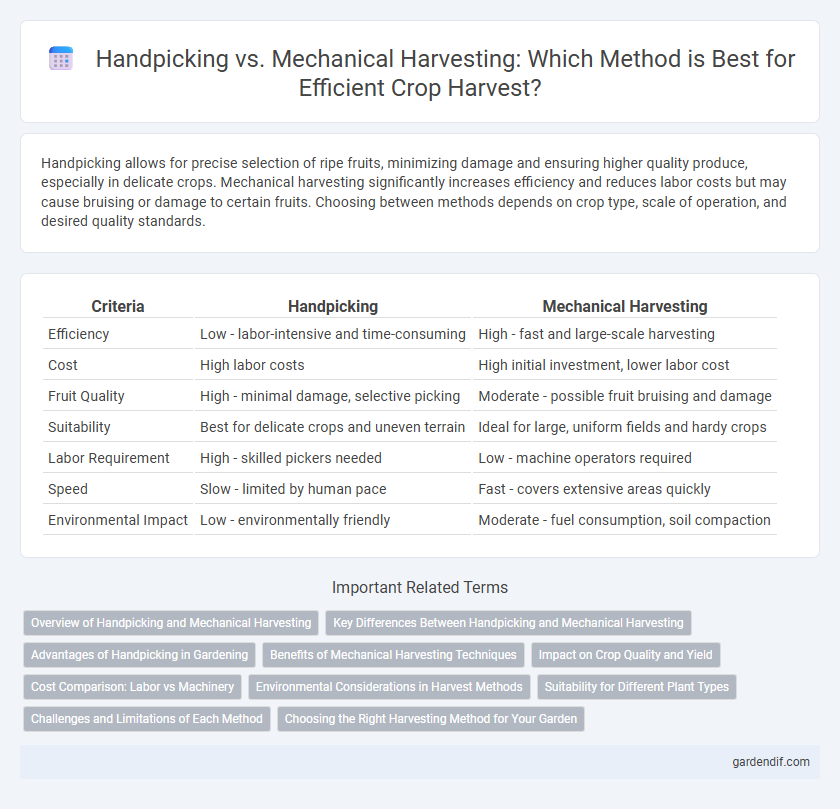
Handpicking vs mechanical harvesting Illustration
Handpicking allows for precise selection of ripe fruits, minimizing damage and ensuring higher quality produce, especially in delicate crops. Mechanical harvesting significantly increases efficiency and reduces labor costs but may cause bruising or damage to certain fruits. Choosing between methods depends on crop type, scale of operation, and desired quality standards.
Table of Comparison
| Criteria | Handpicking | Mechanical Harvesting |
|---|---|---|
| Efficiency | Low - labor-intensive and time-consuming | High - fast and large-scale harvesting |
| Cost | High labor costs | High initial investment, lower labor cost |
| Fruit Quality | High - minimal damage, selective picking | Moderate - possible fruit bruising and damage |
| Suitability | Best for delicate crops and uneven terrain | Ideal for large, uniform fields and hardy crops |
| Labor Requirement | High - skilled pickers needed | Low - machine operators required |
| Speed | Slow - limited by human pace | Fast - covers extensive areas quickly |
| Environmental Impact | Low - environmentally friendly | Moderate - fuel consumption, soil compaction |
Overview of Handpicking and Mechanical Harvesting
Handpicking involves the selective harvesting of crops by laborers, ensuring minimal damage and higher quality, particularly for delicate fruits like grapes and berries. Mechanical harvesting uses specialized machines designed for speed and efficiency, capable of gathering large quantities but sometimes causing bruising or sorting challenges. The choice between handpicking and mechanical harvesting depends on crop type, scale of operation, and desired product quality.
Key Differences Between Handpicking and Mechanical Harvesting
Handpicking offers precise selection and minimal damage, making it ideal for delicate crops like grapes and coffee, while mechanical harvesting prioritizes speed and efficiency for large-scale operations such as wheat and corn. Handpicking requires higher labor costs and more time but ensures superior fruit quality and reduced waste. Mechanical harvesting relies on advanced machinery, reducing labor dependency but potentially causing increased crop bruising and lower quality.
Advantages of Handpicking in Gardening
Handpicking in gardening ensures selective harvesting, preserving fruit quality by minimizing bruising and damage often caused by mechanical methods. This technique allows precise removal of ripe crops, promoting plant health and reducing waste. It also supports sustainable practices by avoiding soil compaction and machinery-related emissions.
Benefits of Mechanical Harvesting Techniques
Mechanical harvesting techniques significantly increase efficiency by enabling faster crop collection over large areas compared to labor-intensive handpicking. Advanced machinery reduces labor costs and minimizes crop damage through precise cutting and handling technologies. Automation and GPS-guided systems enhance yield consistency and optimize harvesting schedules for improved overall productivity.
Impact on Crop Quality and Yield
Handpicking preserves crop quality by minimizing bruising and damage, which is critical for delicate fruits like berries and grapes, ensuring premium market value. Mechanical harvesting increases efficiency and yield potential by covering larger areas quickly, but can cause higher rates of physical damage and contamination, potentially reducing overall product quality. Choosing between handpicking and mechanical methods depends on crop type, labor costs, and desired quality standards in post-harvest handling.
Cost Comparison: Labor vs Machinery
Handpicking requires significant labor costs due to the need for skilled workers, especially during peak harvest seasons, making it expensive but precise. Mechanical harvesting involves high initial investment and maintenance costs for machinery but reduces ongoing labor expenses and increases efficiency on large-scale farms. Cost-effectiveness depends on farm size, crop type, and market value, with handpicking favored for quality-sensitive crops and mechanical harvesting suited for bulk production.
Environmental Considerations in Harvest Methods
Handpicking fruit reduces soil compaction and preserves surrounding vegetation, minimizing habitat disruption compared to mechanical harvesting, which often causes greater environmental strain due to heavy machinery use. Mechanical harvesting consumes significant fossil fuels, contributing to greenhouse gas emissions, whereas handpicking has a lower carbon footprint and supports sustainable agricultural practices. Choosing handpicking over mechanization promotes biodiversity and soil health, essential factors for long-term ecosystem resilience in orchards and farms.
Suitability for Different Plant Types
Handpicking is ideal for delicate fruits like berries and grapes, where minimizing damage is crucial for maintaining quality and flavor. Mechanical harvesting suits hardier crops such as wheat, corn, and apples, enabling faster collection and higher efficiency on large-scale farms. Choosing between handpicking and machinery depends on plant type, crop sensitivity, and harvest volume to optimize yield and product integrity.
Challenges and Limitations of Each Method
Handpicking allows for selective harvesting and reduces fruit damage but is labor-intensive and time-consuming, limiting scalability for large operations. Mechanical harvesting increases efficiency and reduces labor costs but often causes higher rates of bruising and damage, compromising fruit quality. Both methods face challenges in maintaining optimal crop quality while balancing cost-effectiveness and operational feasibility.
Choosing the Right Harvesting Method for Your Garden
Handpicking allows precise selection of ripe fruits and vegetables, minimizing crop damage and preserving plant health, particularly for delicate produce like berries and tomatoes. Mechanical harvesting increases efficiency and reduces labor costs, ideal for larger-scale gardens growing uniform crops such as grains and potatoes. Evaluating garden size, crop type, and quality requirements ensures the optimal balance between yield, cost, and produce quality.
Handpicking vs mechanical harvesting Infographic

 gardendif.com
gardendif.com